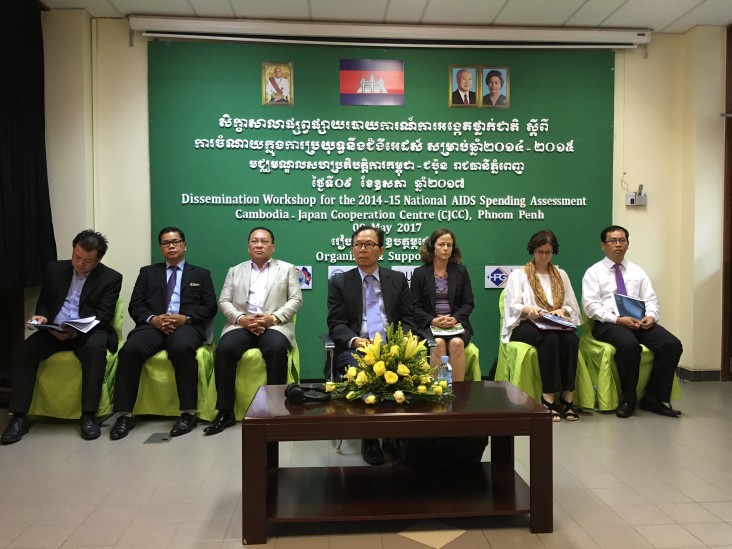
(as prepared for delivery)
- Your Excellency Ieng Mouly, Chair of the National AIDS Authority
- Marie-Odile Emond, Country Representative, UNAIDS
- Civil society representative
- Ladies and gentlemen
It is my pleasure to be here with you today, representing USAID and the U.S. “President’s Emergency Plan for AIDS Relief” – which you may know as PEPFAR.
The National AIDS Spending Assessment, known as NASA, is a very important study that provides data on the actual spending in the country for HIV/AIDS in a year from all sources. While I will not give away the very interesting findings that will be presented by the investigators, I do want to talk about domestic resources and the move towards sustained epidemic elimination in Cambodia.
As we are all aware, Cambodia has made remarkable progress in the fight against HIV/AIDS and is on the verge of achieving its 90-90-90 goals for HIV elimination. This success was the result of shared actions and resources from the government, development partners, civil society, and other key stakeholders. As a former health officer who has worked in many PEPFAR-supported countries, I have been astounded by how Cambodia turned the tide on its HIV epidemic and is poised to become one of the first countries to achieve the AIDS-free Generation.
However, the context in Cambodia looks quite different today than it did at the height of the epidemic in the 1990s and early 2000s. Cambodia’s economy has made impressive gains, with annual growth consistently over seven percent for the past several years. Last year, the World Bank announced that Cambodia had attained Lower Middle Income status. We can see the progress all around us in both urban areas and along the roadways that take us through rural parts of Cambodia.
Financial sustainability is an intersection of epidemiology and economics. Let’s remind ourselves - what exactly does sustainability mean? It is the ability to afford epidemic elimination and to secure stable funding for HIV treatment and prevention. It also implies a health system that supports these services after elimination has been achieved. In Cambodia’s economic environment, the financing for HIV/AIDS will naturally change and evolve. External funding for the response is on a rapid decline, and the dialogue around sustainability is intensifying. While the overall reduction in resources has led to improved efficiency, recent drops in HIV funding are now threatening critical prevention and testing services for the most at risk and vulnerable populations. We all agree that we must preserve the investments and achievements made thus far, even in the face declining resources. I believe we also all agree that the pathway towards sustainability needs to be accelerated. At this critical juncture, it imperative for the Royal Government of Cambodia, the development partners, civil society, and other stakeholders to create a clear plan. A plan that ensures that, once epidemic elimination is achieved, the services, systems, financing, and policies required to maintain that elimination continue to be available.
Cambodia is not alone in making such changes. Domestic HIV investments around the world have grown significantly in recent years. Many countries are making important strides toward a more sustainable future. Over one-third of people living with HIV live in countries where domestic resources finance the majority of ARV purchases. This includes our neighbors Vietnam, Thailand, and Myanmar. Often the first commitments countries make in HIV financing are for ARVs. There are good reasons for that. First, ARVs are life-saving and allow people living with HIV to live a normal life expectancy as productive citizens without transmitting the virus to others. Secondly, ARVs can be easily tracked and accounted for. As a result, many ministries of finance find that funding ARVs is an efficient use of health finances. Other significant areas where domestic resources are invested include human resources, HIV test kits, commodities, laboratory supplies and services for key populations.
For the U.S. government, sustainability of the HIV response means that a country has the enabling environment, and the services, systems, and resources required to control and eliminate the HIV and AIDS epidemic. This includes the financial, human, and organizational capital required to keep systems and services operating. A stable financial resource base is critical for long-term planning and decision-making. Because funding will always be limited, the impact of each dollar must be stretched by ensuring that investments are strategic, effective, and cost efficient.
As Cambodia celebrates its accomplishments over the past two decades, its leaders and partners are working to adapt the program to a rapidly changing landscape. The cost of fighting AIDS and maintaining people on life-long treatment, coupled with flattening donor aid and greater economic growth, are generating new opportunities to expand national ownership and funding of AIDS activities.
The gains have been tremendous. If we continue to ensure every investment has a clear outcome, it is within our grasp not only to eliminate the epidemic but to sustain the elimination of HIV.
Today’s dissemination of the NASA findings provides a set of metrics that we can use to track progress on domestic financing to ensure Cambodia becomes and stays AIDS free. Together, let’s use these metrics to continue the discussion on sustainability and ensure that Cambodia meets its goals to reach 95-95-95 by 2025.
Thank you very much!
Related Speeches
- Remarks by Polly Dunford, Mission Director, USAID Cambodia, Launch Event of Feed the Future Cambodia Harvest II
- Remarks by Christina Lau, Deputy Director, Office of Public Health and Education, USAID/Cambodia, Opening Ceremony of the Kick-Off Workshop for “One Health Workforce”
- Remarks by Veena Reddy, Deputy Mission Director, USAID Cambodia, EPIC Showcase







Comment
Make a general inquiry or suggest an improvement.